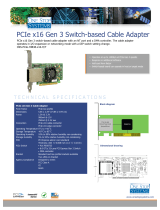
3User's Manual | CMS310
Table of Contents
Chapter 1 - Introduction................................................................................................................6
Specifications ......................................................................................................................... 6
Features .................................................................................................................................. 8
Block Diagram ........................................................................................................................9
Chapter 2 - Hardware Installation ................................................................................................8
Board Layout...........................................................................................................................8
System Memory ..................................................................................................................... 9
Installing the DIMM Module ...........................................................................................9
Removing the DIMM Module ........................................................................................10
CPU ........................................................................................................................................11
Installing the CPU Fan and Heat Sink .......................................................................... 11
Jumper Settings ...................................................................................................................12
CLEAR CMOS Data ........................................................................................................12
DIO Power ......................................................................................................................12
COM1/COM2 RS232/422/485 Select ..........................................................................13
COM1/COM2 RS232 Power Select ..............................................................................14
AT/ATX Mode - JP26 .....................................................................................................15
USB Power Control - JP24 ............................................................................................ 16
Rear I/O Ports .......................................................................................................................17
USB Ports ....................................................................................................................... 18
Graphics Interfaces .......................................................................................................19
RJ45 LAN Ports ............................................................................................................. 20
Audio .............................................................................................................................20
Internal I/O Connectors .......................................................................................................21
SATA (Serial ATA) ..........................................................................................................21
Digital I/O Connector .....................................................................................................21
COM (Serial) ports .........................................................................................................22
Cooling Fan Connectors ................................................................................................23
Power Connector ...........................................................................................................23
Front Panel .....................................................................................................................24
LAN LED Connector .......................................................................................................25
S/PDIF Connector .......................................................................................................... 25
SMBus Connector .........................................................................................................26
LPC Connector ............................................................................................................... 26
PS2 ..................................................................................................................................27
Chassis Intrusion Connector ........................................................................................27
InnoAGE HDR1 (JP27) ..................................................................................................28
InnoAGE HDR1 (JP27) ..................................................................................................28
Expansion Slots .............................................................................................................29
Installing the M.2 Module .............................................................................................29
Battery ............................................................................................................................30
Chapter 3 - BIOS Setup ............................................................................................................... 31
Overview ...............................................................................................................................31
Main .......................................................................................................................................32
Advanced .............................................................................................................................32
ACPI Configuration ........................................................................................................ 33
CPU Configuration .........................................................................................................34
Video Configuration .......................................................................................................34
Audio Configuration.......................................................................................................35
SATA Configuration .......................................................................................................35
USB Configuration .........................................................................................................36
USB Power Control ........................................................................................................36
PCI Express Configuration ............................................................................................ 37
System Agent (SA) Configuration ................................................................................38
ME Configuration ........................................................................................................... 38
Debug Configuration .....................................................................................................39
UEFI Device Manager ....................................................................................................39
SIO NCT6126D ............................................................................................................... 40
Console Redirection ......................................................................................................42
Security .................................................................................................................................43
Boot .......................................................................................................................................43
Exit ......................................................................................................................................... 45
Updating the BIOS ................................................................................................................ 45
Notice: BIOS SPI ROM..........................................................................................................45
Chapter 4 - RAID ..........................................................................................................................46
RAID Levels Description ......................................................................................................46
Setup Procedure ................................................................................................................... 46





















